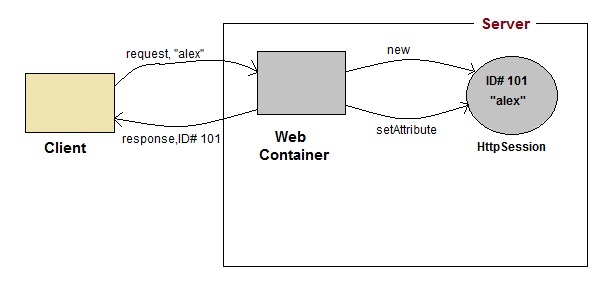What is HttpSession?
HttpSession object is used to store entire session with a specific client. We can store, retrieve and remove attribute from HttpSession object. Any servlet can have access to HttpSession object throughout the
getSession() method of the HttpServletRequest object.How HttpSession works
- On client's first request, the Web Container generates a unique session ID and gives it back to the client with response. This is a temporary session created by web container.
- The client sends back the session ID with each request. Making it easier for the web container to identify where the request is coming from.
- The Web Container uses this ID, finds the matching session with the ID and associates the session with the request.
HttpSession Interface
Some Important Methods of HttpSession
| Methods | Description |
|---|---|
long getCreationTime() | returns the time when the session was created, measured in milliseconds since midnight January 1, 1970 GMT. |
String getId() | returns a string containing the unique identifier assigned to the session. |
long getLastAccessedTime() | returns the last time the client sent a request associated with the session |
int getMaxInactiveInterval() | returns the maximum time interval, in seconds. |
void invalidate() | destroy the session |
boolean isNew() | returns true if the session is new else false |
void setMaxInactiveInterval(int interval) | Specifies the time, in seconds,after servlet container will invalidate the session. |
Complete Example demonstrating usage of HttpSession
All the files mentioned below are required for the example.
index.html
<form method="post" action="Validate"> User: <input type="text" name="user" /><br/> Password: <input type="text" name="pass" ><br/> <input type="submit" value="submit"> </form>
web.xml
<web-app..>
<servlet>
<servlet-name>Validate</servlet-name>
<servlet-class>Validate</servlet-class>
</servlet>
<servlet>
<servlet-name>Welcome</servlet-name>
<servlet-class>Welcome</servlet-class>
</servlet>
<servlet-mapping>
<servlet-name>Validate</servlet-name>
<url-pattern>/Validate</url-pattern>
</servlet-mapping>
<servlet-mapping>
<servlet-name>Welcome</servlet-name>
<url-pattern>/Welcome</url-pattern>
</servlet-mapping>
<welcome-file-list>
<welcome-file>index.html</welcome-file>
</welcome-file-list>
</web-app>
Validate.java
import java.io.*;
import javax.servlet.*;
import javax.servlet.http.*;
public class Validate extends HttpServlet {
protected void doPost(HttpServletRequest request, HttpServletResponse response)
throws ServletException, IOException {
response.setContentType("text/html;charset=UTF-8");
String name = request.getParameter("user");
String pass = request.getParameter("pass");
if(pass.equals("1234"))
{
//creating a session
HttpSession session = request.getSession();
session.setAttribute("user", name);
response.sendRedirect("Welcome");
}
}
}
Welcome.java
import java.io.*;
import javax.servlet.*;
import javax.servlet.http.*;
public class Welcome extends HttpServlet {
protected void doGet(HttpServletRequest request, HttpServletResponse response)
throws ServletException, IOException {
response.setContentType("text/html;charset=UTF-8");
PrintWriter out = response.getWriter();
HttpSession session = request.getSession();
String user = (String)session.getAttribute("user");
out.println("Hello "+user);
}
}




No comments:
Post a Comment